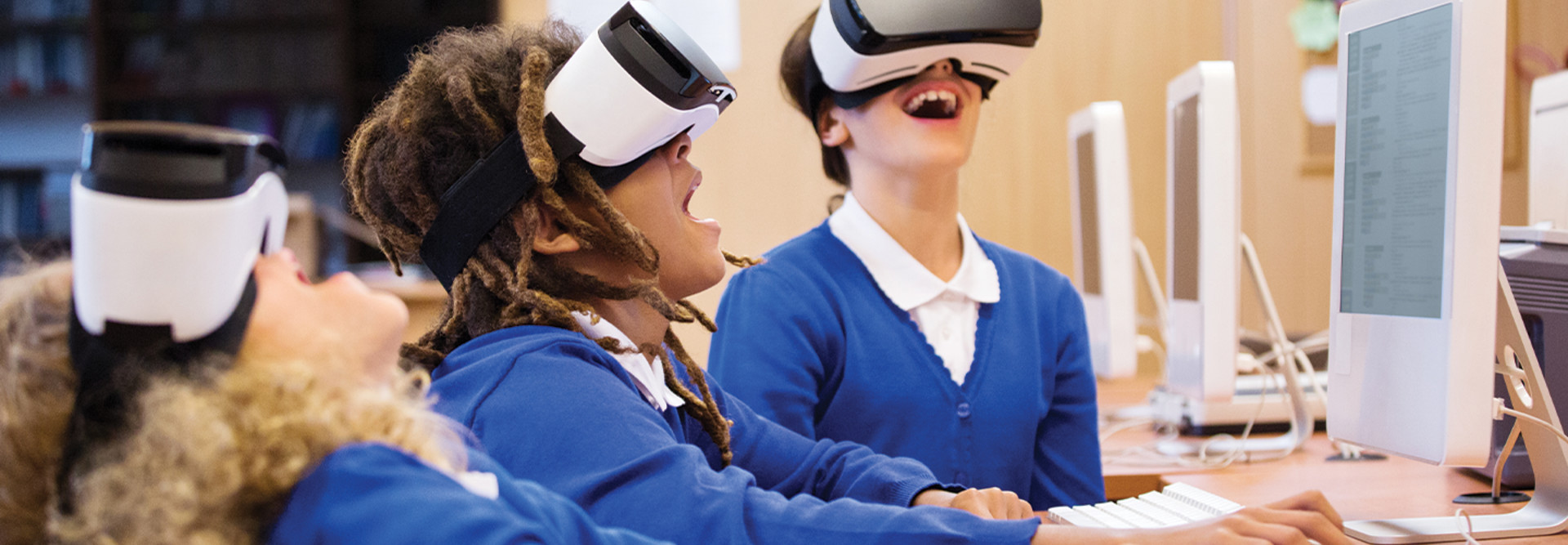Schools Face Barriers to VR Adoption in the Classroom
“I hear and I forget, I see and I remember, I do and I understand” is a Chinese saying that speaks to the wisdom and hope educators have about how revolutionary learning with VR can be, thanks to its power to facilitate experiential learning, and it’s an approach that immersive technology solutions experts and researchers have used as well.
If the reality of VR’s pedagogical potential still seems far-fetched, consider this: VR headsets allow students to walk alongside dinosaurs or study the flora and fauna of rainforests by virtually trekking through them. Students can even dissect frogs without using a scalpel. And VR exercise games are getting sedentary students moving in physical education classes.
“AR [augmented reality] and VR educational applications shift the learning process from passive to active, allowing students to interact with content and practice their knowledge in real-time conditions,” said ABI Research Analyst Eleftheria Kouri in a press statement on the release of the report “Augmented and Virtual Reality in Education.” ABI forecast that by 2023, the total value of AR in education will be approximately $5.3 billion; for head-mounted VR tools used in education, the value will surpass $640 million.
And yet, despite all of VR’s exciting potential applications within education, schools face real barriers in implementing this technology as a core part of their curriculum.
MORE FROM EDTECH: AR/VR in K–12: Schools Use Immersive Technology for Assistive Learning
The Cost of VR Tools Can Be Daunting
Operating with the realities of tight budgets and competing demands for those funds, many school districts are reluctant to invest in what seem like expensive gadgets with no immediate tangible benefits.
“Cost is the primary challenge of AR/VR tools in most markets, and especially so in education,” the ABI report notes. “Funding is one of the primary barriers for massive adoption of AR/VR solutions within educational systems, due to the high cost of headsets along with the limited financial resources in many schools.”
Schools may also find it difficult to understand the value in VR at the outset.
“ROI in education looks different in comparison, which can make it more difficult to identify actual value. Raising education efficacy, retention, and engagement among learners can be measured quantitatively through grades and overall performance, but also qualitatively in morale and approach to work, which new AR/VR experiences can track,” notes ABI.
The cost barrier may be coming down, though. ABI predicts the average sale price for AR glasses will be $733 for monocular and $347 for binocular by 2023. VR devices cost less than AR tools, and their stand-alone headsets are expected to trend down toward $200 by 2023. “Ease of setup and use with standalone devices make it a favorite for educational purposes,” ABI notes about VR headsets.
MORE FROM EDTECH: Mixed Reality Brings New Life to K–12 Classrooms
There’s a Lack of Knowledge About What VR Really Is
Some observers say schools balk at adopting new educational technologies because they don’t want to change the curriculum until an emerging technology, such as VR, proves effective. But waiting for a technology to prove its efficacy with certainty before implementing might be fundamentally flawed thinking.
“The problem at the core is that technology cannot be effective until the curriculum is fundamentally changed to allow for specific technologies to be integrated in meaningful ways. If, however, the curriculum will not be changed until each technology is proven effective, this is a standoff and counter-productive to progress,” notes the U.S. Army Research Institute for the Behavioral and Social Sciences.
Part of the reason for this value-versus-cost standoff is that school administrators lack the “theoretical ammunition” to understand how transformative VR technology can be in the classroom, notes Steve Bambury, head of digital learning and innovation at JESS Dubai, in an article on his blog VirtualiTeach. That’s because many people don’t fully understand what virtual reality is or they have a misconception that VR is little more than 360-degree images or videos.
“True VR has to be experienced to be understood. … the single most important thing you can do to help them understand the power of VR is have them try it for themselves. … They need that penny-drop moment — which totally makes sense since this is a brand new medium for which they have no frame of reference!” he notes.
MORE FROM EDTECH: Check out how K–12 teachers are using VR to teach computer science.
Parents Are Anxious About Effects of VR on Children
While parents are generally enthusiastic about the use of VR tools in schools, they worry along with administrators that entering a virtual world might have adverse effects on students.
Sixty percent of all parents surveyed said they are at least “somewhat concerned” about VR’s negative health effects, including 30 percent who are “very concerned,” according to a 2018 report from Common Sense Media, written by Jeremy Bailenson, founder of the Virtual Human Interaction Lab at Stanford University.
It’s true that using VR headsets can cause nausea, motion sickness and eye strain. In addition, violent content viewed in an immersive medium can cause acute stress.
Still, as with most technology and its use by students, moderation and careful monitoring by schools is key.
“For children, moderation should prevail. Instead of hours of use, which might apply to other screens, think in terms of minutes. Most VR is meant to be done on the five- to 10-minute scale,” said Bailenson.
Students should have only VR experiences that their parents and teachers would want them to live with the memory of in the real world. “Traveling to the moon is fine, but scary experiences will stay with them,” said Bailenson.








